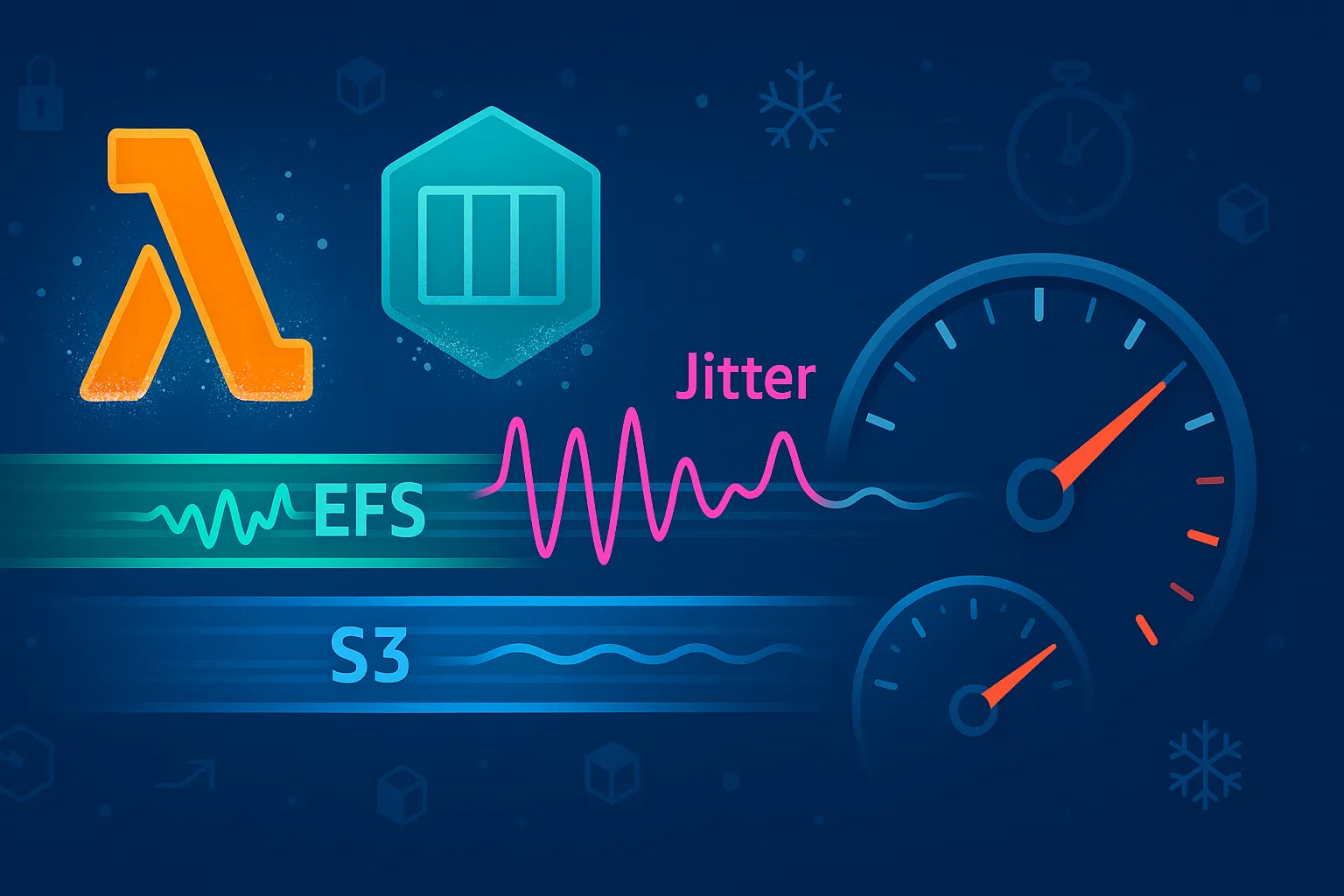In the dynamic world of cloud computing, serverless architectures like AWS Lambda and Fargate ECS are celebrated for their scalability and efficiency. Yet, beneath their convenient abstractions, lie complexities that can impact performance in ways not immediately apparent. This is particularly true for network-bound operations, where the unpredictability of underlying hardware can introduce significant ‘jitter’ or variability in performance.
For developers and IT professionals navigating this terrain, understanding these nuances is crucial. Our investigation zeroes in on this very aspect - the extent of jitter in AWS’s serverless environments, focusing on the cold startup performance of AWS EFS and S3 within AWS Lambda and Fargate ECS rather than the peak performances.
AWS services, known for their robustness and versatility, show a contrasting behaviour in our tests. EFS, especially, displayed a startlingly high level of jitter, with up to a 13x difference in network transfer speed, while S3 maintained a relative consistency. This finding is pivotal, suggesting that serverless solutions might not be the panacea they are often thought to be, especially for network-intensive tasks.
In this blog post, we delve into an empirical exploration of these performance variations. Our objective is not just to highlight the existence of potential jitter in AWS Lambda and AWS ECS during cold starts, but to quantitatively measure and analyze its impact. Whether you’re a seasoned AWS user or new to cloud computing, this exploration into the less-travelled paths of serverless performance will offer valuable perspectives.
Background: Understanding AWS Services
AWS S3 and EFS
Amazon S3 (Simple Storage Service) is a highly scalable, secure, and durable object storage service, widely used for a variety of storage solutions, from backup and recovery to data lakes. AWS Elastic File System (EFS) provides a simple, scalable, elastic file storage system for use with AWS Cloud services and on-premises resources. It’s designed to provide massively parallel shared access to thousands of Amazon EC2 instances.
AWS Lambda and Fargate ECS
AWS Lambda is a serverless computing service that lets you run code without provisioning or managing servers. It automatically scales your application by running code in response to each trigger. AWS Fargate ECS (Elastic Container Service) is a serverless compute engine for containers. Fargate removes the need to provision and manage servers, letting you specify and pay for resources per application.
The Genesis of Our Investigation
Our journey into this deep dive began with a curious observation in our AWS environment. While scaling our ECS tasks during periods of intensive load, we encountered an intriguing pattern: newly created tasks demonstrated extremely variable performances, particularly in their interactions with AWS Elastic File System (EFS). This inconsistency wasn’t just a minor fluctuation; it was stark, raising questions about the underlying network performance and stability in a serverless architecture.
This variability was not merely a technical anomaly but a potential red flag for any environment relying on consistent performance for optimal operation. In a landscape where milliseconds can impact user experience and efficiency, such fluctuations needed a thorough examination. We knew this was more than a one-off issue — it was a window into the often opaque world of serverless computing performance.
Driven by a need to understand and quantify this variability, we embarked on a comprehensive benchmarking study. Our goal was clear: to explore, measure, and analyze the network performance of AWS serverless services, particularly Lambda and Fargate ECS, in their interaction with EFS and S3. This was not just about satisfying technical curiosity; it was about gaining insights crucial for anyone architecting, deploying, and scaling applications in AWS’s serverless ecosystem.
Why It Matters
In serverless architectures, understanding network performance is crucial. It affects everything from application responsiveness to operational costs. In environments where resources are abstractly managed, issues like network jitter can introduce significant challenges, often unnoticed until they impact critical operations.
Test Setup and Methodology
Environment Setup
Our tests were carried out in a well-configured AWS environment.
For this test we used the eu-west-1/Ireland region. Services are running
in a purpose built VPC network.
Lambda Setup:
- AWS Lambda with 10GB of memory
- custom runtime based on Amazon Linux 2023
- ARM64 architecture
- Isolated custom VPC
Fargate Setup:
- AWS Fargate ECS with 8 vCPUs and 32GB memory
- ARM64 architecture
- The container is based on Amazon Linux 2023 and uses the same binary as AWS Lambda, ensuring consistency across both services.
- Isolated custom VPC
S3 config:
- VPC endpoint
EFS setup:
- Performance mode: General Purpose
- Throughput mode: Elastic
- Encryption enabled
- VPC endpoint
We prepared an array of files of varying sizes for our tests, located on both S3 and EFS. These included files ranging from 1MiB to 1000MiB. This range was crucial to examine throughput under different data loads.
Our testing involved a specific application designed to randomly select one of these files and then measure the download throughput. This approach allowed us to gather comprehensive data on the transfer rates. We ensured all the performance metrics were accurately logged into AWS Cloudwatch for analysis. The test ran multiple times during the day for a month.
We set up the test in such a way that the execution would most likely be from a cold start in order to minimize the effects of caches.
Benchmarking Process
To ensure a comprehensive evaluation of network performance in serverless AWS environments, our benchmarking process was designed with a focus on precision and relevance.
Process Overview:
- File Selection: Our application, running both on AWS Lambda and Fargate ECS, was programmed to randomly select one file from our predefined set of different sizes (ranging from 1MiB to 1000MiB) on S3 and EFS. This random selection was to simulate a variety of real-world scenarios, ensuring our results covered a broad spectrum of use cases.
- Throughput Measurement: Once a file was selected, the application proceeded to download it completely. The core metric we focused on was the throughput, specifically measuring the speed of downloading all the bytes of the file. This approach provided us with a direct measure of network performance, giving us realistic speeds achievable in these serverless environments on a cold start. The measurement only covered the transfer time on the network and not the function/container initialization.
- Data Logging: To capture and analyze the data accurately, every test result – including the file size, the time taken to download, and the throughput – was automatically logged into AWS Cloudwatch. This allowed us to gather a large dataset for a thorough analysis.
- Repetition for Reliability: Recognizing the importance of reliability in our findings, we repeated this process multiple times across various times of the day for a month and under different load conditions. This repetition helped in mitigating anomalies and capturing a more consistent picture of the network performance.
- Cold Start Analysis: A key aspect of our testing was understanding the impact of cold starts. By initiating tests from a cold start state, we were able to capture the initial performance characteristics, which are critical in understanding the real-world behaviour of these services.
- Comparative Analysis: Lastly, by running these tests in both AWS Lambda and Fargate ECS environments, we were able to draw direct comparisons between the two, offering insights into the performance nuances unique to each service.
End Goal:
The ultimate goal of our benchmarking was to understand the real-world network performance of AWS Lambda and Fargate ECS, particularly during cold starts. Rather than seeking peak throughput, our focus was on realistic performance scenarios — what developers and IT professionals are likely to experience in daily operations. This approach was designed to provide a practical understanding of these services’ reliability and consistency under varying conditions. It’s about setting realistic expectations for throughput during the critical initial response times in serverless computing, which is crucial for application planning and architecture decisions.
Unveiling the Results
S3 vs EFS
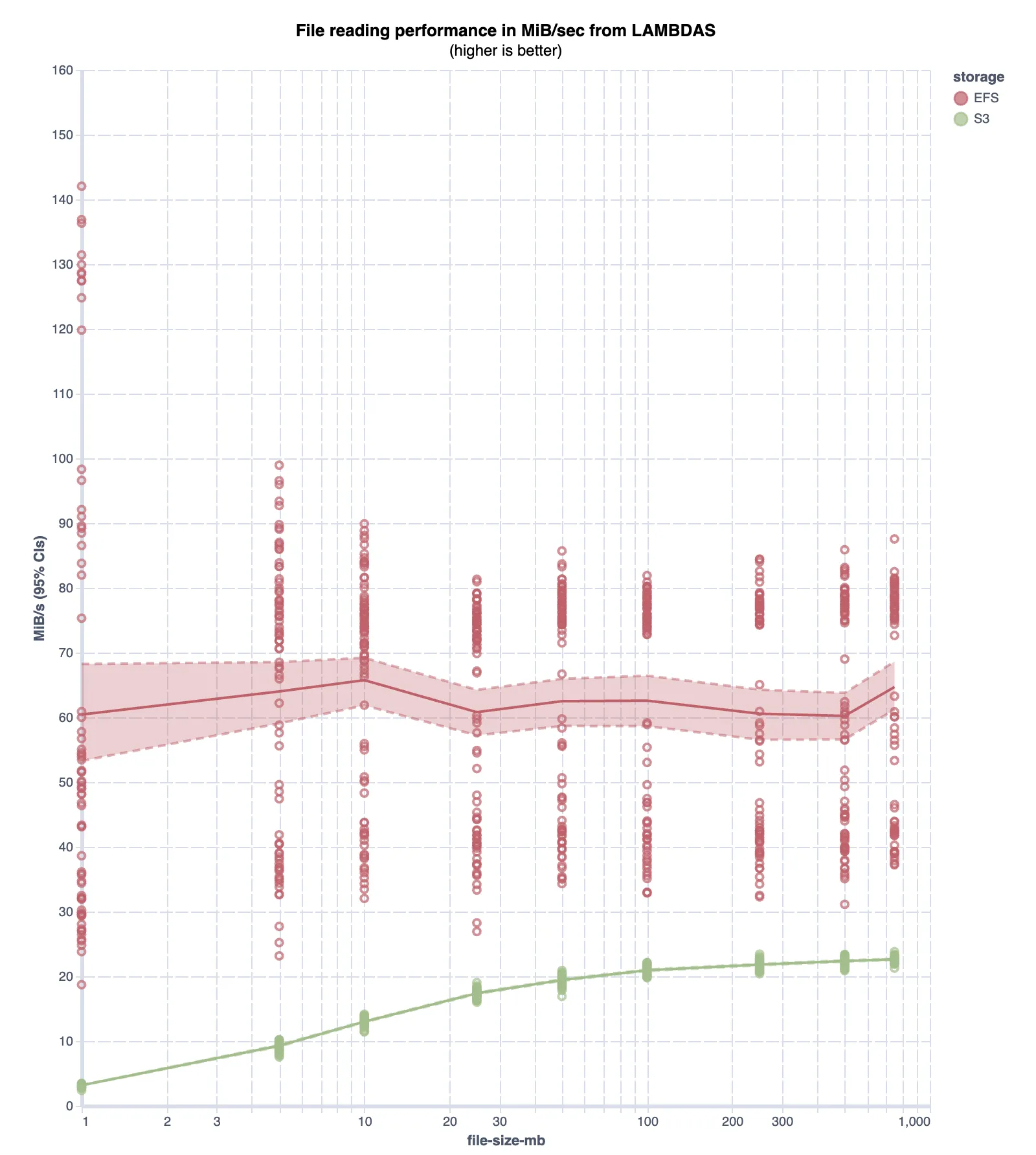 Our month-long study generated a wealth of data, revealing striking differences
in read performance between AWS S3 and EFS, when accessed from a cold-start AWS
Lambda function. The results are illustrated in a scatterplot graph, where file
sizes are plotted on the X-axis against the read throughput (measured in MiB/s)
on the Y-axis. Overlaying this scatterplot is a line representing the mean read
throughput, with a 95% confidence interval, giving us a clear visual
representation of the average performance and its variability.
Our month-long study generated a wealth of data, revealing striking differences
in read performance between AWS S3 and EFS, when accessed from a cold-start AWS
Lambda function. The results are illustrated in a scatterplot graph, where file
sizes are plotted on the X-axis against the read throughput (measured in MiB/s)
on the Y-axis. Overlaying this scatterplot is a line representing the mean read
throughput, with a 95% confidence interval, giving us a clear visual
representation of the average performance and its variability.
Key Observations:
- EFS Variability: The most noticeable observation is the considerable variability in EFS’s performance. Unlike the relatively stable throughput of S3, EFS displayed a wide range in throughput rates, particularly noticeable when reading smaller files (≤ 1MiB).
- Bi-Modal Nature of EFS: Interestingly, the EFS performance exhibited a bi-modal distribution. This pattern indicates two distinct ‘modes’ of operation or performance levels, which could be an artifact of underlying infrastructure or configuration differences within the AWS environment.
- S3’s Increasing Throughput: In contrast, S3 demonstrated a more predictable behaviour. Our data showed a clear trend: as the file size increased, so did the S3 throughput. This consistency is a crucial factor for applications where predictability in performance is as important as the performance itself.
- Comparative Speed: When directly compared, the read throughput from Lambda for EFS was, on average, three times faster than that for S3. However, this increased speed comes with the trade-off of higher variability and less predictability in performance.
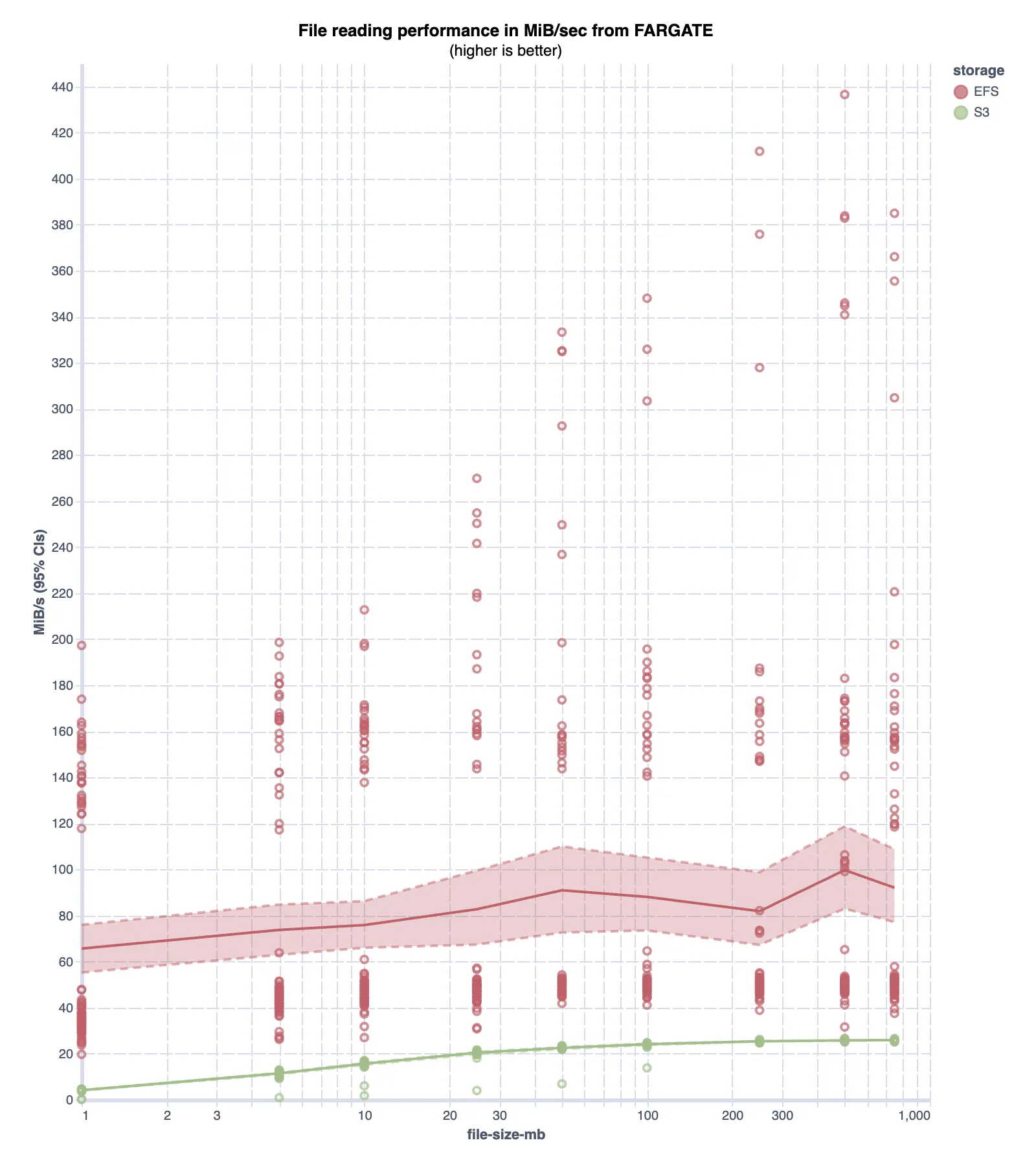 Extending our analysis, we turn our attention to the performance dynamics when
reading from a cold-start Fargate ECS task. The plot, similar in structure to
our previous Lambda analysis, reveals some stark contrasts in read performance,
especially concerning EFS.
Extending our analysis, we turn our attention to the performance dynamics when
reading from a cold-start Fargate ECS task. The plot, similar in structure to
our previous Lambda analysis, reveals some stark contrasts in read performance,
especially concerning EFS.
Key Observations:
- Heightened EFS Instability: In the Fargate ECS environment, EFS read throughput displayed even greater instability than observed with Lambda. This performance exhibited a pronounced bi-modal distribution, similar to the previous example.
- Extreme Jitter in EFS Performance: The variability in EFS read times was striking. For instance, reading a 500 MiB file fluctuated drastically, taking anywhere from as little as 1.1 seconds to as long as 15.8 seconds.
- Comparative Delays: On average, we observed that reading the same file in Fargate ECS could be up to 9.47 times slower compared to our baseline measurements, with extreme cases showing a slowdown of up to 13.8 times.
Lambda vs Fargate ECS
The following plots compare how AWS Lambda and Fargate ECS each performed in reading from S3 in a cold-start scenario.
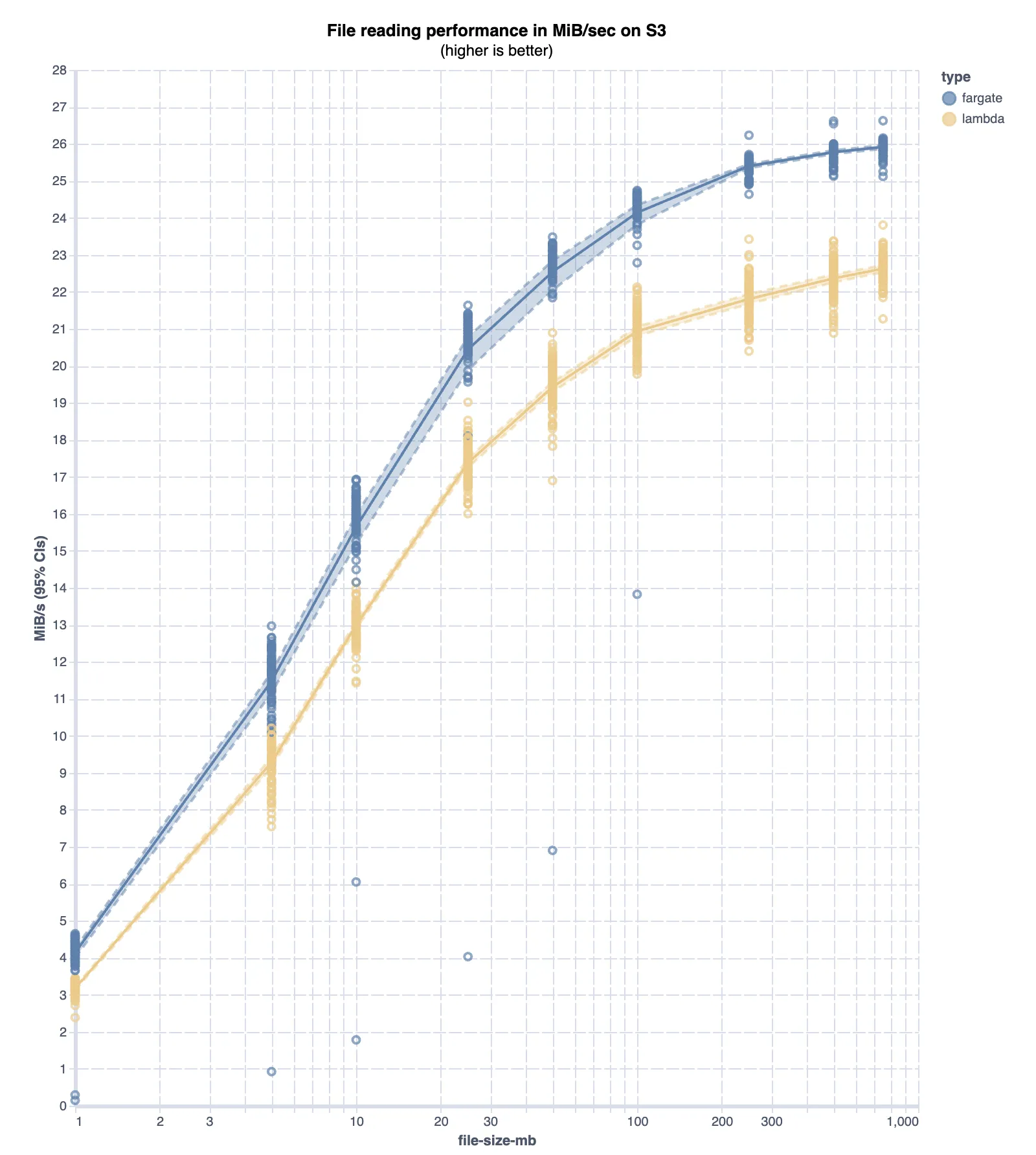 The first plot illustrates the throughput variations when reading files from S3
in both Lambda and Fargate ECS environments. You can see a trend as the file size
increases, so does the throughput, with performance starting to level off after
reaching the 300 MiB mark. What stands out is the predictability of S3’s
performance.
The first plot illustrates the throughput variations when reading files from S3
in both Lambda and Fargate ECS environments. You can see a trend as the file size
increases, so does the throughput, with performance starting to level off after
reaching the 300 MiB mark. What stands out is the predictability of S3’s
performance.
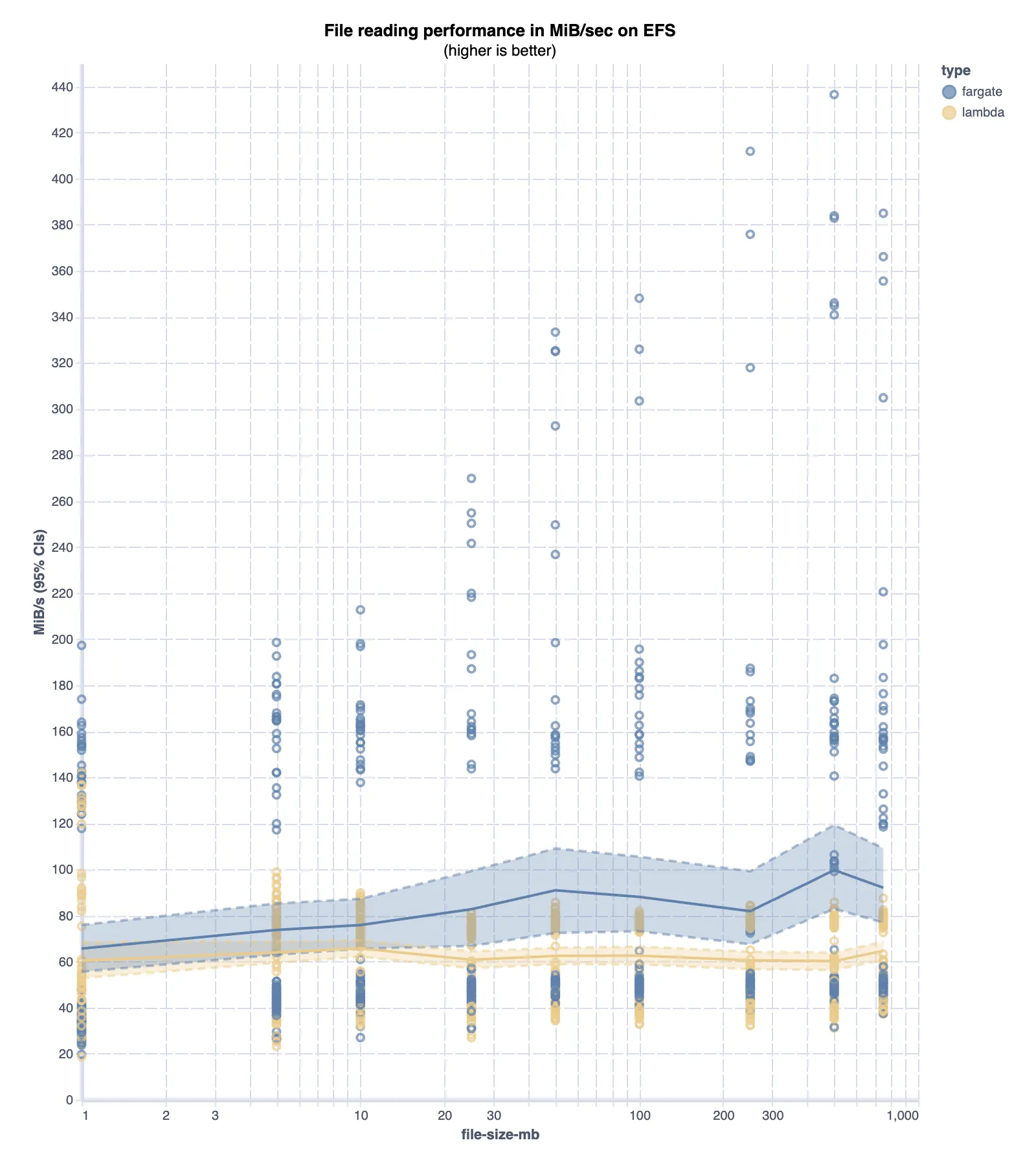 The above plot focuses on EFS performance, comparing file read operations from
Lambda and Fargate ECS. The results are intriguing. While average performances
are similar between the two environments, Fargate ECS occasionally offers
superior performance. However, this boost in performance seems to depend largely
on luck, given the lack of control users have over the underlying infrastructure
beyond container size.
The above plot focuses on EFS performance, comparing file read operations from
Lambda and Fargate ECS. The results are intriguing. While average performances
are similar between the two environments, Fargate ECS occasionally offers
superior performance. However, this boost in performance seems to depend largely
on luck, given the lack of control users have over the underlying infrastructure
beyond container size.
Comparative Insights
The next two charts are a scatter plot of the read performance over time.
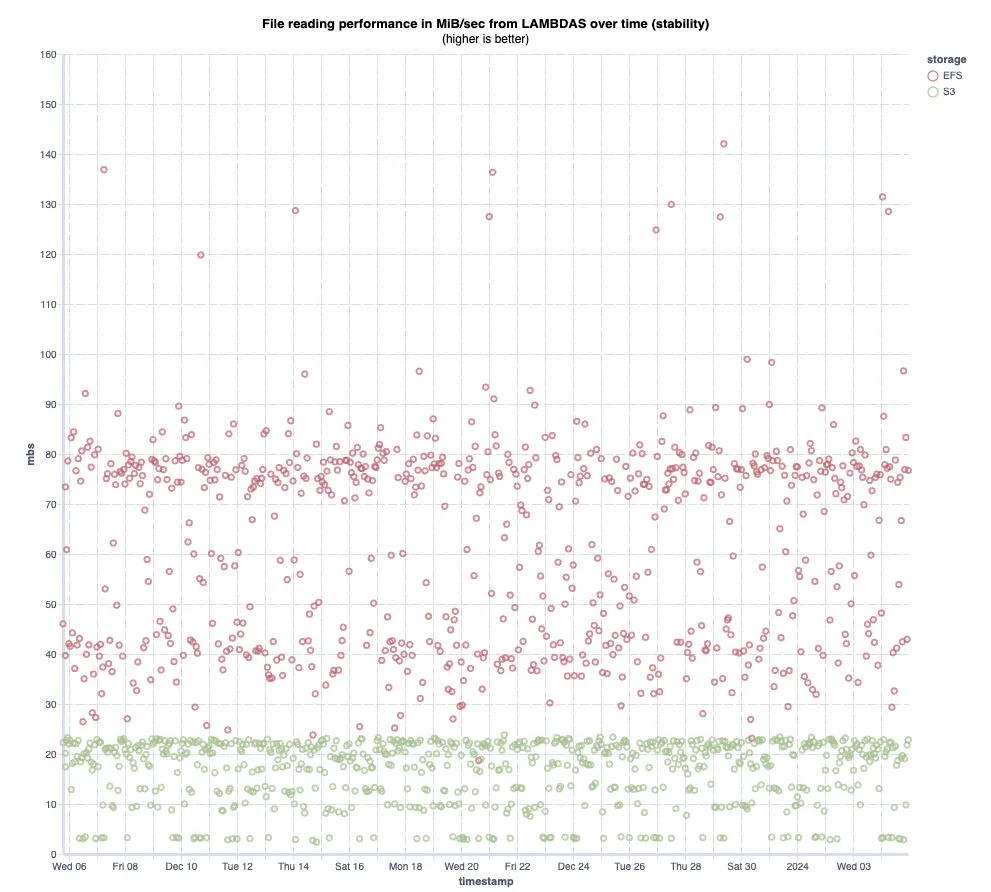
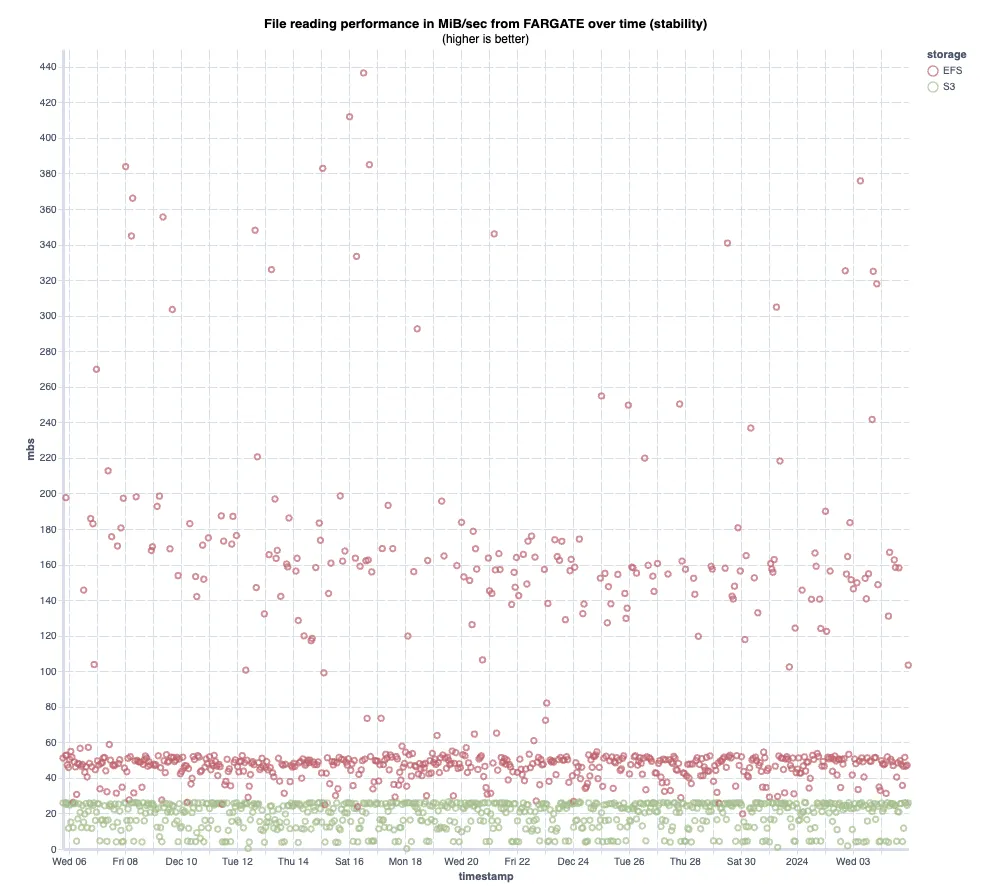
These findings paint a picture of AWS’s serverless storage options. While EFS offers faster read speeds on average, its performance variability, especially with smaller files, could be a limiting factor for certain applications. On the other hand, S3’s more stable and predictable throughput, albeit slower, might be more suitable for scenarios where consistency is paramount.
Conclusion
The results of this experiment were extremely surprising, although we had suspected some level of variability we didn’t expect so much jitter going into this. We were not expecting to see such a variance of performance from EFS. These findings highlight that while serverless architectures offer many advantages, they also come with their own set of challenges, particularly in network-bound operations.
In scenarios where applications are network-intensive, especially during cold startups, serverless might not be the optimal choice. This is crucial for applications requiring consistent network performance. However, it’s important to note that serverless solutions do excel in scenarios where the primary demands are CPU and memory-bound. In these cases, the scalability and efficiency of serverless computing can be fully leveraged to great effect.
Feel free to download the data gathered during this expirement and run your own analysis.
